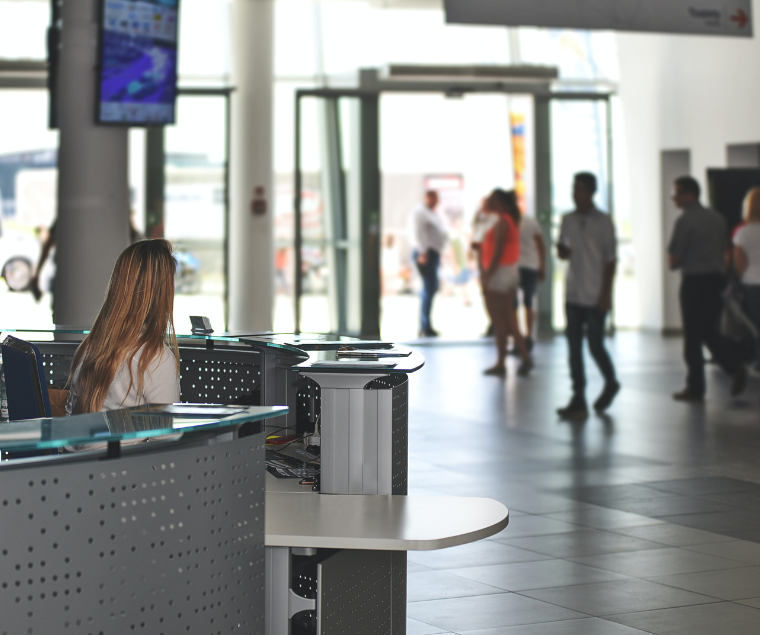When people go to a government institution, they expect to experience plenty of hassles. These buildings often have confusing hallways, slow service, and long queues. Improving directions and communication within these facilities can help boost customer satisfaction levels. Also, it can lead to a more positive experience for employees and visitors. Here are a few critical locations for your government building signage.
#1 – Lobby
Unfortunately, many government institutions are not known for their efficiency and exceptional customer service. You can change that perception with digital signage. These digital signs can help make the experience more pleasant than in the past. The signage will bring awareness to certain services, modernize the lobbies, and enhance your image.
Digital lobby signs can also alert visitors about the wait time for certain services. You can even add some entertaining videos to keep people occupied while waiting in line. Sharing social media is another way to distract people from the long waits. Consider sharing YouTube streams, Facebook posts, or Instagram videos. Those social media campaigns can help engage members of the community. Queue management is extremely important, and you can integrate your digital signage with it. Many people don’t like the mystery of waiting. When you display queue numbers, it shows that the line is moving, which can help reduce your visitors’ frustration.
#2 – Entrances
All government institutions must deal with an influx of visitors daily. As a result, traffic control is a top priority for many of these facilities. With a digital directory at the entrance, you can solve some traffic problems. These digital signs can point visitors to the bathrooms, conference rooms, and other offices. Traditional signage can be difficult to change, especially when someone relocates to a different part of the building. While you could create a temporary paper sign, that is not a professional solution. You can quickly change digital signs in a few seconds.
With a digital sign management system, you can update names, contact information, and office lists. When visitors look for a local, state, or government office, they can quickly locate it on the sign, reducing confusion.
Many government institutions want more high-tech ways to improve their signage. With that, you may want to invest in touchscreen directories for the facility. This screen allows visitors to interact with the building and find the right place on the map. Some digital screens enable the visitor to change their language, giving them a more inclusive experience. Once again, digital entrance signage is an excellent way to post news, weather, emergency alerts, and upcoming events.
#3 – Wayfinding Areas
People can become frustrated walking from one location to another to find the right office or department. Receptionists and other staff members can often be overwhelmed, meaning they are not always available to provide directions. Digital wayfinding signs are the perfect solution to address these issues. You can rely on something other than the traditional methods for wayfinding signs. Use these signs with interactive kiosks to display directions to offices, departments, and other amenities.
You could also use these kiosks to give people an option to complete some small tasks. Instead of heading to a specific office, they could have their questions answered at the kiosk. Like the other types of signs, adding digital signage to wayfinding spots is the perfect way to keep everyone informed about events, emergency alerts, and policy changes.
#4 – Outside Courtrooms
Courthouses have daily schedules that you must share with employees and visitors to ensure they get to the right locations. If there is no signage, a visitor might not locate the proper courtroom, causing them to be late for a hearing. These signs can alleviate some of your staff members’ problems. Instead of issuing directions, they can focus on their duties. Digital signs can display real-time schedules with the names of the presiding judge and attorneys.
You might also consider digital signage that displays a map to get visitors to the right location. Some signs could even include check-in procedures to help reduce backups. Showing that information on a digital board can save money on printing and paper costs. You can easily change the information on the display with a click of a button for your daily notifications.
#5 – Hallways
Hallways are the perfect space to serve as an informational hub for your government facility. The building often hosts a wide range of other services, such as health clinics, libraries, and municipal offices. You can use colorful images and bright graphics to make the visitors more aware of these other services in the building. Some government institutions use digital screens to help engage with the community. Consider adding a video wall to educate visitors about local ordinances or share news around the town.
These digital dashboards are an excellent tool to alert visitors of a real-time emergency. Unfortunately, bad weather, fires, and health threats are common. You need to be able to get that information to visitors quickly. You can also implement digital screens to promote wellness and safety in your community. If you have a natural disaster, use these digital signs to send a notification to staff members and visitors within the building.
Use These Signs in Your Government Institutions
Digital signage can improve the lives of your staff members and help the community better engage with your facility. If you want to find more ways to incorporate digital signs into your organization, reach out to Tupp Signs. Since 1928, we have helped businesses and organizations get the most out of their signs. Schedule a consultation by calling 302-322-1600.


